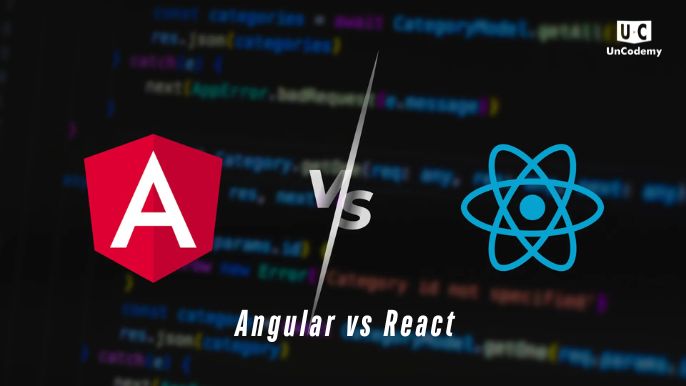Angular vs React: A Comprehensive Comparison for Web Developers

- Angular
- Frontend Development
- Full Stack
- React
- UI Components
- web development
Introduction to Frontend Development Frameworks
Frontend development frameworks provide pre-written code to help developers create the user interface of websites and applications. These frameworks save time and effort by offering a set of tools, libraries, and guidelines that ensure consistency and streamline development. They enable developers to focus on building high-quality features while abstracting away the repetitive tasks of manual coding.
Frontend Development Framework Comparison
Frontend development frameworks play a crucial role in building modern web applications. With many frameworks available, it can be challenging to choose the best one for your project. The most popular frameworks today—Angular and React—each have distinct features and advantages. In this blog, we will compare these frameworks to help you make an informed decision about which one to use for your next web development project.
Angular and React
Angular is a full-fledged front-end framework developed and maintained by Google. It’s been around since 2010 and has evolved significantly over the years. Angular is an opinionated framework that provides a set of tools and guidelines to build single-page applications (SPAs). It uses TypeScript, a statically typed superset of JavaScript, which can be a great advantage for larger projects.
React, on the other hand, is a JavaScript library developed by Facebook, initially released in 2013. Unlike Angular, React is more focused on building user interfaces (UIs). It’s often described as a library for creating components, and it allows developers to choose their own tools for things like routing, state management, and API interaction.
Key Differences Between Angular and React
Architecture
- Angular: Follows an MVC (Model-View-Controller) architecture and provides everything out of the box including routing, forms, and HTTP handling.
- React: Uses a component-based architecture focused on rendering UI components. Additional libraries are often used for routing and state management.
Learning Curve
- Angular: Has a steep learning curve due to its complexity and features like dependency injection, RxJS, and decorators.
- React: Easier to start with for developers familiar with JavaScript. The learning curve is flatter and tools can be added as needed.
Development Speed and Productivity
- Angular: Offers a full development environment, enabling rapid development with fewer third-party libraries.
- React: Requires integration of additional libraries but offers flexibility to choose the best tools for each feature.
Performance
- Angular: Uses two-way data binding which may lead to performance issues in complex applications.
- React: Uses one-way data flow and a virtual DOM, resulting in faster rendering and better performance.
Key Features Comparison
Data Binding
- Angular: Two-way data binding helps keep model and view in sync but may affect performance in large apps.
- React: One-way data binding offers better control and predictability, making debugging easier.
TypeScript vs JavaScript
- Angular: Built with TypeScript, offering strong typing, interfaces, and better tooling.
- React: Can be used with both JavaScript and TypeScript, giving developers flexibility.
Tools and Ecosystem
- Angular: Comes with built-in tools like Angular CLI for project creation, testing, and deployment.
- React: Relies on external libraries like Redux, React Router, and Next.js for full functionality.
Advantages and Disadvantages of Angular and React
Advantages of Angular
- Complete framework with built-in tools and features.
- Two-way data binding keeps model and view in sync.
- TypeScript offers better code quality and IDE support.
- Comprehensive documentation and community support.
Disadvantages of Angular
- Steep learning curve due to complexity.
- Heavy framework, which may impact load time for smaller apps.
Advantages of React
- Component-based architecture promotes reusability.
- Efficient virtual DOM improves performance.
- Large ecosystem of third-party tools and libraries.
- React Native allows building cross-platform mobile apps.
Disadvantages of React
- Requires boilerplate code for additional features.
- Frequent updates can make it hard to keep up with best practices.
When to Use Angular
- Enterprise-level applications: Best suited for complex, large-scale projects.
- Long-term support: Offers scalability and maintainability through structured architecture.
- TypeScript-based teams: Ideal for teams already familiar with TypeScript.
When to Use React
- Highly interactive UIs: Great for dynamic and user-driven interfaces.
- Fast, flexible development: Perfect for rapid prototyping and iterative development.
- Small to medium applications: Lightweight and efficient for simpler projects.
Angular vs React (2025): A Short Comparison
In 2025, Angular and React remain top choices for frontend development.
- Angular: Comprehensive, TypeScript-based, and ideal for enterprise-level apps with built-in features for routing, forms, and more.
- React: Lightweight, JavaScript-based, component-driven, and best for building fast, interactive UIs with the flexibility to choose tools.
Best Framework for Web Development
- React: Best for SPAs, dashboards, and real-time apps.
- Angular: Ideal for enterprise-grade applications with built-in features.
- Vue.js: Great for small-to-medium apps and rapid development.
- Svelte: Excellent for performance-critical apps due to minimal runtime.
- Next.js: Built on React, perfect for SEO-friendly and server-rendered apps.
Choose based on your project’s size, complexity, and performance needs.
Community Support and Popularity
- Angular: Backed by Google with regular updates but has declined in popularity due to complexity.
- React: Backed by Meta, with a huge community, massive ecosystem, and growing popularity.
Full Stack Development Course: Bridging Frontend and Backend
When deciding between Angular and React, it's essential to consider how they integrate into a full-stack workflow. Both frameworks excel in UI development and pair well with backend technologies to build scalable applications. A Full Stack Development course can help bridge this gap by teaching both frontend and backend skills, allowing developers to build robust, end-to-end solutions efficiently.
✅ Conclusion
The decision between Angular and React depends on your project's needs and your team’s skills:
- Choose Angular: For enterprise applications that need structure, built-in tools, and long-term support.
- Choose React: For flexible, fast-paced development with high interactivity and performance.
Both frameworks are excellent choices—select the one that aligns best with your goals and development workflow.



 TRENDING
TRENDING BESTSELLER
BESTSELLER BESTSELLER
BESTSELLER TRENDING
TRENDING HOT
HOT BESTSELLER
BESTSELLER HOT
HOT BESTSELLER
BESTSELLER BESTSELLER
BESTSELLER HOT
HOT POPULAR
POPULAR